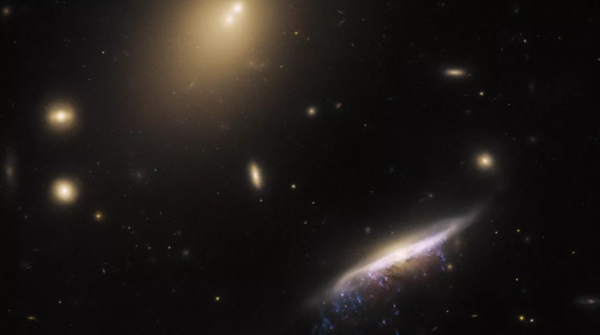In a stunning Hubble Space Telescope image, a faraway spiral galaxy has dazzling streams of star-forming gas flowing from its core disk like jellyfish tentacles.
JW100 is an example of a “jellyfish galaxy” – a kind of galaxy that shows extended tendrils lighted by clusters of star formation that appear to be flowing away from the galaxy’s main body, giving it a jellyfish-like look.
Hubble takes pictures of jellyfish in space with a bright star
According to a statement(opens in a new tab) made by the European Space Agency (ESA) on Monday, these tendrils originate through a process known as ram pressure stripping, which occurs when galaxies approach the diffuse gas that pervades galaxy clusters (March 20).
As galaxies pass through this tenuous gas, it acts as a headwind, removing gas and dust off the galaxy and forming the distinctive following streamers seen on JW100, according to an ESA release.
The Hubble Space Telescope caught JW100 from the side, revealing the galaxy’s core bulge of stars, gas, and dust, as well as its dazzling spiral arms. Jellyfish-like blue threads are seen below the galaxy, stretching in a patchwork pattern.
JW100 is located in the bottom right corner of the Hubble view, surrounded by six minor elliptical galaxies and a much bigger elliptical galaxy, IC 5338, which is the bright patch of diffuse light towards the image’s top. These galaxies are all part of the same galaxy cluster. The cluster’s brightest galaxy, IC 5338, is categorized as a cD galaxy and contains two cores.
“It is not uncommon for cD galaxies to have numerous nuclei since they are believed to expand by eating smaller galaxies, whose nuclei can take a long time to be absorbed,” ESA experts added. “The dazzling specks of light around its outer edges represent a dense population of globular clusters.”
As part of an effort to examine star formation in the tendrils of jellyfish galaxies, the Hubble image was captured with the space telescope’s Wide Field Camera 3.
ESA officials said in a statement, “These tendrils depict star formation under severe conditions and might help astronomers comprehend the process of star creation elsewhere in the cosmos.”

